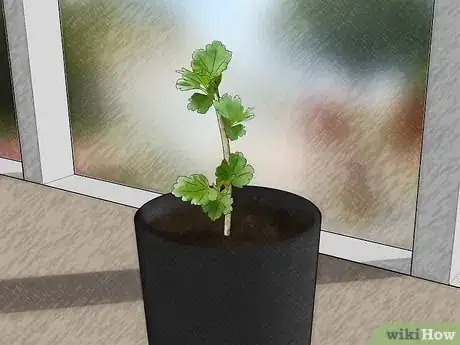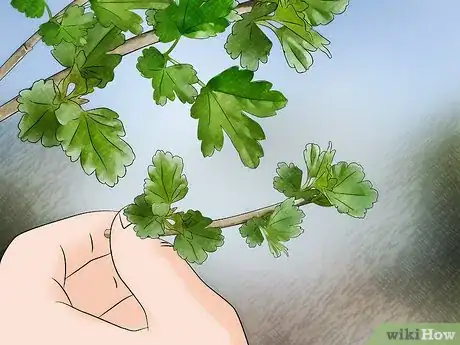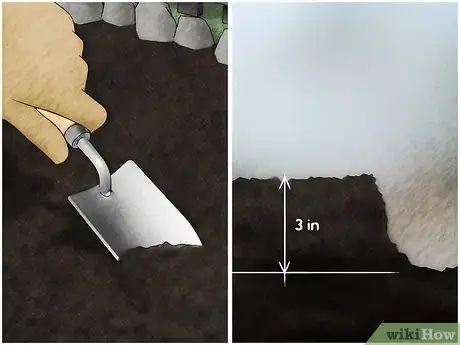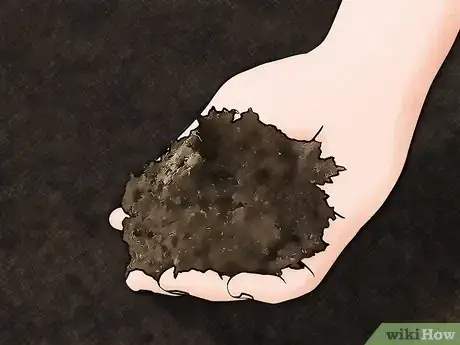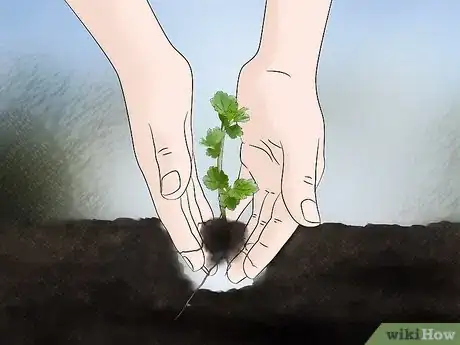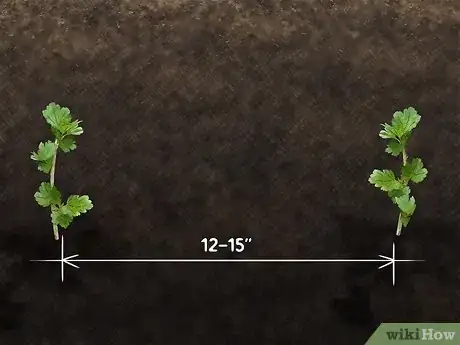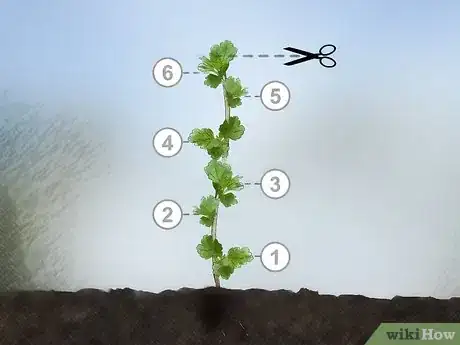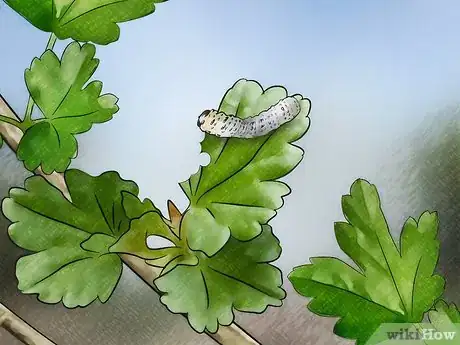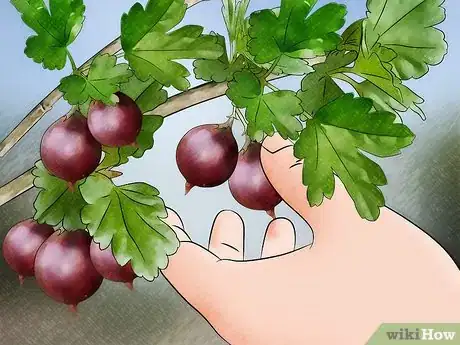This article was co-authored by Lauren Kurtz. Lauren Kurtz is a Naturalist and Horticultural Specialist. Lauren has worked for Aurora, Colorado managing the Water-Wise Garden at Aurora Municipal Center for the Water Conservation Department. She earned a BA in Environmental and Sustainability Studies from Western Michigan University in 2014.
This article has been viewed 42,204 times.
Semi-translucent green in colour, gooseberries (Ribes grossularia) are ideal for dishes requiring a crisp acidity to complement either sweet or savoury dishes. Gooseberries are great for garden spaces with a lot of shade. Berries grown in shade will produce fruit that tastes more tart and tasty than fruit grown in the sun.[1] There are many simple ways to ensure your Gooseberries grow healthily, from sourcing your clippings, preparing your plot, planting, and finally growing your Gooseberries.
Steps
Preparing Gooseberries
-
1Get potted gooseberry clippings from a nursery. Gooseberry clippings from a nursery can be purchased year round, will likely come potted, and can be planted anytime between autumn and spring. Potted gooseberry plants will often be simpler to plant as they should already have small root systems established.[2]
- Consult your local plant nursery for special gooseberry clippings, like strains that are disease resistant or strains that are known for larger yields.
-
2Get bare-root gooseberry clippings from an older gooseberry bush. If you are getting your clippings from a wild bush, or your clippings are unpotted, be sure your clippings are from a 2-3 year old bush with 3-5 main branches and a head of at least 4-6 inches. You will need to keep your bare-root clippings cool and moist if not planted immediately, and they will need to be soaked in water for about 4 hours before planting.[3]
- Wrap the root in a moist paper towel, place the root in a cup or glass, and set in the fridge until you are ready to plant.
- Consult your local nursery about whether or not you should plant already potted or wild clippings in your climate.
Advertisement -
3Prepare your planting plot the autumn before you intend to plant. Preparing your plot in advance of planting will include choosing a well ventilated site with adequate moisture and making sure your soil is loose to optimize growth. Take a shovel and loosen the soil to a depth equivalent to the height of the rootball, which is the mass of roots under the stem, and over a wide area to prevent compaction and improve drainage.[4]
- If you have bare root clippings they will not have a root ball. Instead, loosen the soil around a depth of 3 inches.
- If your plot becomes waterlogged over the winter, simply loosen the soil again and plant your clippings on a slight mound, approximately 3-4 inches high.[5]
-
4Use heavy, nutrient-rich, and well drained soil. Creating a nutrient rich plot is key during preparation as you will not be adding fertilizer during the planting period. Combine your existing soil with organic matter, like compost and fertilizer, during your initial plot preparation. If your original soil is sandy you many need to apply generous amounts of compost and/or fertilizer.[6]
- Consult your local plant nursery about your soil type and about acquiring organic matter for plot preparation.
Planting Gooseberries
-
1Plant gooseberries in a cool spring climate. Gooseberries thrive in cooler climates and will often not produce fruit until a frost has passed. Plant your gooseberries early in spring, or as soon as the ground is workable, as gooseberry clippings can survive temperatures as low as 55 degrees. The earlier you plant your gooseberries, the better and more established the plants will be.[7]
- Although gooseberries will grow in warmer climates, their distinct tartness is better in cooler areas.
-
2Plant gooseberries in holes deeper and wider than their root systems. Gooseberry plants should have a 1 inch margin in depth and a margin approximately 3 times the diameter in width when planted. This will encourage growth and allow plenty of room for the initial roots to take hold. Once planted, gently pack the soil to firm the ground around the roots.[8]
- If your clippings are having difficulty staying vertical try attaching them to a bamboo cane with horizontal wires.[9]
-
3Plant each clipping equally spaced apart. Spacing your plants apart will ensure that they have enough room and light to grow and will encourage their root systems to grow wide. Clippings should be spaced approximately 12-15 inches apart and replanted bushes approximately 4-5 feet apart.[10]
Growing and Harvesting Gooseberries
-
1Scatter mulch. Scatter 2-4 inches of organic mulch in the form of wood chips, pine needles, or compost immediately after your clippings are planted. Mulch cools the soil, conserves water, and suppresses weeds, which is preferable in shaded plots and essential in sunny plots.[11]
- If you do not have a compost at home you can purchase mulch at your local plant nursery.
- Renew your mulch each year after planting.
-
2Prune your clippings. After planting, prune all clippings down to 4-6 buds above ground. This will encourage new vibrant and initial growth and the development of vigorous new stems, or canes, that will be able to last years.
- Prune your plant each year in late winter or early spring to encourage new growth and healthy development.
- Consult pruning guides for instructions on how to prune your gooseberry plant as it becomes more established over the years.[12]
-
3Look for insect and disease symptoms in late spring. Insect and disease infestations are rare and uncommon. If they do present themselves it is unlikely that they will ruin your entire crop. However, they are important to look for in order to keep you gooseberry bush as healthy as possible and to not affect its future fruitings.
- The best way to prevent insect infestations and diseases is to keep a healthy plant by selecting good planting soil, adequate amounts of water, plenty of light, and consistently removing dead leaves and branches.
-
4Check for powdery mildew in mid-summer. Powdery mildew can present itself during hotter months, and is therefore less common in cooler climates. However, you can prevent powdery mildew by making sure your gooseberry bush is planted in a well ventilated area with plenty of light, which will inhibit the distribution of powdery mildew spores.
- Check with your local nursery about potential pesticides or sprays that can reduce the chances of contracting powdery mildew, or inquire about powdery mildew resistant strains.
-
5Water during dry-spells. Dry and windy conditions are especially likely to cause water shortage in your soil. Even if your soil feels damp the roots of your gooseberry plant may be dry. Set up an irrigation system or set a daily routine of watering your plant to ensure it is receiving the moisture it needs in order to produce the best fruit possible.[13]
- Keep in mind that even wet and rainy summers rarely give enough moisture to plants. You will almost always need to set-up alternate means of watering.[14]
-
6Know when to harvest. Gooseberries should generally be ready to harvest in early July. Knowing when to harvest Gooseberries depends on their taste and on your intended use for them. If you plan on cooking with Gooseberries try picking them while they a bit unripe and tart. If you’d like to eat them raw keep tasting until the fruit becomes sweeter.
Expert Q&A
-
QuestionDo gooseberry bushes need lots of sun?
 Lauren KurtzLauren Kurtz is a Naturalist and Horticultural Specialist. Lauren has worked for Aurora, Colorado managing the Water-Wise Garden at Aurora Municipal Center for the Water Conservation Department. She earned a BA in Environmental and Sustainability Studies from Western Michigan University in 2014.
Lauren KurtzLauren Kurtz is a Naturalist and Horticultural Specialist. Lauren has worked for Aurora, Colorado managing the Water-Wise Garden at Aurora Municipal Center for the Water Conservation Department. She earned a BA in Environmental and Sustainability Studies from Western Michigan University in 2014.
Professional Gardener Gooseberry shrubs can grow in sun and shade conditions. Depending on the variety, some will produce more fruit in full sun. Most varieties will wilt with hot afternoon sun. Some experts believe there is a distinctive flavor change in berries grown in sun versus shade.
Gooseberry shrubs can grow in sun and shade conditions. Depending on the variety, some will produce more fruit in full sun. Most varieties will wilt with hot afternoon sun. Some experts believe there is a distinctive flavor change in berries grown in sun versus shade. -
QuestionDo gooseberry bushes need pruning?
 Lauren KurtzLauren Kurtz is a Naturalist and Horticultural Specialist. Lauren has worked for Aurora, Colorado managing the Water-Wise Garden at Aurora Municipal Center for the Water Conservation Department. She earned a BA in Environmental and Sustainability Studies from Western Michigan University in 2014.
Lauren KurtzLauren Kurtz is a Naturalist and Horticultural Specialist. Lauren has worked for Aurora, Colorado managing the Water-Wise Garden at Aurora Municipal Center for the Water Conservation Department. She earned a BA in Environmental and Sustainability Studies from Western Michigan University in 2014.
Professional Gardener Yes, prune them after 4-5 years of growth, and every year or two years to remove dead branches, overcrowded areas, and old growth. You can also prune the bush to the desired shape.
Yes, prune them after 4-5 years of growth, and every year or two years to remove dead branches, overcrowded areas, and old growth. You can also prune the bush to the desired shape. -
QuestionHow big do gooseberry bushes grow?
 Lauren KurtzLauren Kurtz is a Naturalist and Horticultural Specialist. Lauren has worked for Aurora, Colorado managing the Water-Wise Garden at Aurora Municipal Center for the Water Conservation Department. She earned a BA in Environmental and Sustainability Studies from Western Michigan University in 2014.
Lauren KurtzLauren Kurtz is a Naturalist and Horticultural Specialist. Lauren has worked for Aurora, Colorado managing the Water-Wise Garden at Aurora Municipal Center for the Water Conservation Department. She earned a BA in Environmental and Sustainability Studies from Western Michigan University in 2014.
Professional Gardener Under optimum conditions, they can grow to be 3 ft tall and 6 ft wide. If they don't get the right amount of sun or water, they may be smaller.
Under optimum conditions, they can grow to be 3 ft tall and 6 ft wide. If they don't get the right amount of sun or water, they may be smaller.
Things You'll Need
- Garden space
- Stake
- Fertilizer compost, manure, mulch
- Shovel
- Gooseberry clippings
References
- ↑ https://www.crfg.org/pubs/ff/gooseberry.html
- ↑ https://www.rhs.org.uk/advice/grow-your-own/fruit/gooseberries
- ↑ https://www.rhs.org.uk/advice/grow-your-own/fruit/gooseberries
- ↑ https://www.rhs.org.uk/advice/grow-your-own/fruit/gooseberries
- ↑ https://www.rhs.org.uk/advice/grow-your-own/fruit/gooseberries
- ↑ https://www.rhs.org.uk/advice/grow-your-own/fruit/gooseberries
- ↑ https://www.rhs.org.uk/advice/grow-your-own/fruit/gooseberries
- ↑ https://www.rhs.org.uk/Advice/profile?pid=237
- ↑ https://www.rhs.org.uk/advice/grow-your-own/fruit/gooseberries
About This Article
To grow gooseberries, start by getting a gooseberry clipping from a nursery or an older gooseberry plant sometime in early spring. Then, plant the clipping outdoors in nutrient-rich, well-draining soil, making sure the hole is deeper and wider than the roots. Next, right after planting, scatter 2-4 inches of organic mulch to keep the soil cool and moist. After you plant your gooseberry clipping, water it daily and wait until mid-summer to harvest it. To learn how to treat pests on gooseberries, scroll down!
